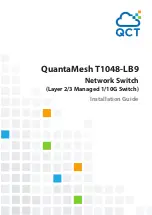
Installation
2-7
1558A APS
2.6.2
Path B Preservice Testing
Perform the following test steps to verify that the 1558A can
run error free data from the DTE port to the NET B Port and
back (local loop test). The test setup for performing this test
is depicted in
Figure 2-2
.
1)
Connect a T1 test set to the DTE RJ48 jack at the rear
of the 1558A unit. The test set should be configured to gen-
erate a T1 signal that matches the options previously set in
the 1558A unit (D4 or ESF, AMI or B8ZS) and configured
to supply clock to the 1558A (internal).
NOTE: If the 1558A DTE is configured for AMI opera-
tion, the test sets must be set up to generate either a 511,
2047, or 1:7 pattern. If the 1558A is configured for B8ZS
on the DTE and NET sides, any pattern may be used (511,
2047, 1:7, QRSS, 3:24, etc.). When sending a 1:7 pattern,
though, some T1 test sets inherently cause generation of a
yellow alarm condition.
2)
Verify that there is no connection at the NET B jack.
3)
Manually operate the front panel Path Select Switch to
the (B) position. This forces and locks the unit to Path B.
The following status LEDs associated with Path A testing
should be illuminated on the unit:
• Power A or B LED ON (green)
• Status ‘Locked’ LED ON (yellow)
• Status Path Active ‘B’ ON (green)
• The Path Status, Alarm B (red) LED may be ON or OFF
depending on the alarm timer setting (0 to 900 seconds)
configured in the 1558A)
4)
The 1558A unit is now looped back to the DTE port
and the T1 test set should be running in sync and error free.
If not, verify that the T1 test set framing and line coding set-
ting match the settings configured in the 1558A.
The 1558A unit is now looped back to the DTE port and the
T1 test set should be indicating that it is detecting pattern
sync and running error free. If so, the preservice local test-
ing is complete. If not, verify that Steps 1 - 3 have been
completed properly. If there is still a problem, perform the
following:
• Loop the T1 test set to itself and verify that test set runs
error free.
• Verify that the T1 test set is properly configured to operate
with the options set in the 1558A (D4 or ESF, AMI or
B8ZS).
• Also verify that the T1 test set is configured to supply
clock (internal).
2.6.3
Results
The stand-alone preservice testing verifies the operational
integrity of the 1558A. If either Path A or Path B failed, but
not both, and the options have been verified, the user should
contact the factory for additional assistance (refer to the
‘General’ chapter).
2.6.4
End-to-End Pre-Service Testing
The following paragraphs describe preservice APS testing
of the 1558A when it is initially connected to the T1 facili-
ties (Path A and Path B) and is configured with another
1558A APS at the far end.
After completing the stand- alone preservice test procedures,
the 1558A is ready to be connected to the Path A and Path B
T1 facilities for verification of end -to-end operation. These
test procedures will verify the following:
• End-to-End Error Performance of Path A
• End -to-End Error Performance of Path B
The following steps assume that there is a near end unit and
a far end unit and a technician with a T1 test set located at
both the near and the far end of the APS service.
1)
Attach the Path A and Path B T1 facilities to the
respective NET A and NET B modular jacks at the rear of
the unit (both near and far locations).
2)
There are four basic methods of configuring the 1558A
which directly impact the settings used in the test sets. Con-
figure both T1 test sets per one of the following scenarios:
• 1558A DTE side configured for D4 framing and T1 NET
sides configured for ESF.
• 1558A DTE side configured for ESF framing, and NET
sides configured for ESF.
• 1558A DTE side configured for AMI line coding and NET
sides configured for B8ZS line coding.
• 1558A DTE side configured for B8ZS line coding and
NET sides configured for B8ZS line coding.
NOTE: If the 1558A DTE is configured for AMI opera-
tion, the test sets must be set to generate either a 511,
2047, or 1:7 pattern. If the 1558A is configured for B8ZS
operation, any pattern may be used (511, 2047, 1:7,
QRSS, 3:24, etc.). When sending a 1:7 pattern, though,
some T1 test sets inherently cause generation of a yellow
alarm condition.
Make sure that one of the test sets is set for internal and that
the other is set for recovered clock.
3)
Once the test sets have been configured similar to the
1558A units, connect the near and the far test set to the
DTE RJ48 jack located at the rear of the 1558A units.















































